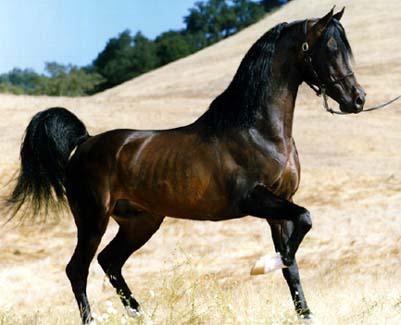
5:44 p.m. - 2007-05-02
Wild Horses
Greetings, O fellow lovers of spring!
Isn't it spectacular outside? Last night on our evening run I couldn't stop commenting to R about the beauty everywhere. The Mississippi was shining blue; the golden sun slanting against the new green leaves of the river bluffs. Ah.
It made the fact that our asses were dragging a bit less painful.
Critter newz:
Is Knute less cute? R told me he found an article complaining that the bear is growing homelier as he gets older. Here is the original article.
What is stinky in Fargo?!
Man, I try to keep this stuff positive, but...Save the Honeybees!
I already sent this link to my soul-siblings in the B family, as we watched "Babel" together. It was a good movie, but the tension was so high, and it lasted SO LONG. I'm apparently not the only one to feel anxious!
Finally, things are gearing up for the Kentucky Derby!
Speaking of horsies, let's learn about them today!
My budster and former roomie D brought a horse fact to my attention when he visited a few weeks ago. He said horses did something called "cribbing" where they "get high" from biting wood. Upon further research, I've found cribbing is indeed a problem. Horses bite on a wooden post and inhale, swallowing the air. This damages the teeth and also can cause weight loss and colic, a main cause of death for horses.
To alleviate this problem, horse owners can use special cribbing tack to help prevent the chewing behavior, or try to change the horse's companionship or daily routine.
In other news, Wendell wants a pet horsey!
Look at this Arabian!
Equus caballus, the horse, is a large odd toed ungulate. These animals are part of the ancient Perissodactyla order, which includes Equidae, and the families belonging to tapirs and rhinos.
Because scientists have yet to crack the horse genome, several theories of their heritage exist. Some scientists believe horses all came from one original strain, and were selectively bred for the characteristics found in modern breeds. Other people believe modern horse breeds descend from four ancient families:
Warmblood subspecies (heavy horses)
Draft subspecies (including ponies)
Oriental subspecies (including Arabians)
Tarpan subspecies (Asiatic, dun colored)
The tarpan was an Asian wild horse that died out in the 19th century. Some German dudes are "back breeding" or selectively breeding horses that have the characteristics of the extinct horse.
The world's only true wild horse is Przewalski's horse, also known as the Mongolian Wild Horse. There are some of these dudes at the Minnesota Zoo!
Wild horse cousins include zebras, donkeys and unagers.
Horses usually live 25 to 30 years. The oldest horse in history died at age 62. The smallest horses are the Falabellas, which were developed in Patagonia and are the size of a large dog. The largest horse is the shire horse, this magnificent draft:
Fuzzy feet!
Horses are measured in "hands". The cut off between "horse" and "pony" is 14.2 hands, or 58 inches, at the whithers, or shoulder region of the horse. There are some exceptions to this rule.
Ponies are stockier than horses, with heavier bone structure and thicker hair. They were perhaps developed for children to ride, or to work in areas where larger horses couldn't fit.
La la la here's a picture now!
For the most part, horses senses are better than humans. They are prey animals, after all. Next to the ostrich, horses have the largest eyes in the animal kingdom, and can see 350 degrees around their heads. Horsey ears can rotate all the way around, and their tender lips can pick up the tiniest grains.
Horses "nap" for four to fifteen hours throughout the day, while standing up. They can't acheive REM sleep while standing though, so they will lie down for a few hours every couple of days. This is especially easy to do in a herd situation, where other horses will stand watch near the reclining ones.
A previously mentioned weakness of the horse is its digestive system. Although horses can digest cellulose (plant matter) in their cecum, or water stomach, they can't vomit. Therefore stomach disorders are some of the most deadly for equines. A 1,000 pound horse will eat 15 to 25 lbs of food a day, along with ten to twelve gallons of water.
The gestation period for horses is about 335 to 340 days. Colts, or baby boys, usually take a few days longer than fillies, baby girls. After four years foals are considered breedable adults, although some horses continue to grow after that time.
Most "wild" horses nowadays are actually creatures descended from domesticated animals of the past. Apparently there were horses on the North American continent 10,000 years ago, but they disappeared. Scientists don't know why.
Now, like my internet friend Ree, some folks are kind enough to give land to these wild herds and feed them in rough times.
Horses have truly shaped man's world for a long time, perhaps since 4,500 B.C.E., where it is thought they were first domesticated in Asia.
But mostly I think they're beautiful, and want to take riding lessons some day. The summer before I moved to MN, I planned on taking riding lessons,but then my transmission went out and I had to blow my savings on that instead. Horses also remind me of further back in my childhood, and the little girl whose grandparents used to live next door. When I found out *she had her own horse* at home, I had to go into the den and cry jealously! And you know I had a huge unicorn figurine collection....
But, I did see some cute horsies at my animal temp job today! So I got that going for me, which is nice.
Huggies,
Wendell!
|


